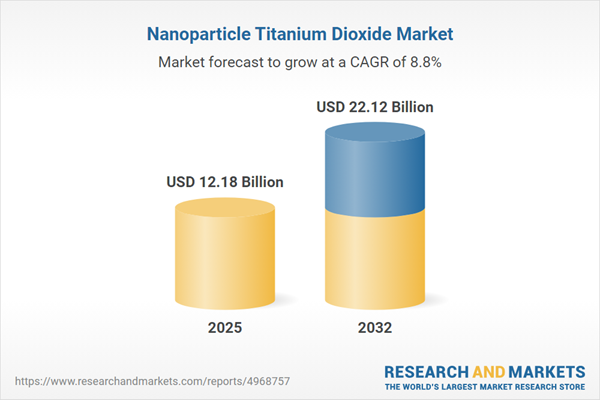Speak directly to the analyst to clarify any post sales queries you may have.
The nanoparticle titanium dioxide market is evolving rapidly, powered by its unique properties and growing integration into critical industrial applications. As sustainability, regulatory compliance, and advanced manufacturing drive procurement priorities, understanding this market's dynamics is a strategic imperative for organizations targeting long-term growth.
Market Snapshot: Nanoparticle Titanium Dioxide Market
The nanoparticle titanium dioxide market grew from USD 11.25 billion in 2024 to USD 12.18 billion in 2025. It is expected to continue expanding at a CAGR of 8.80%, reaching USD 22.12 billion by 2032. The robust demand is fueled by adoption across sectors such as cosmetics, coatings, healthcare, and sustainable energy, supported by its outstanding optical, catalytic, and UV-blocking properties.
Scope & Segmentation
This comprehensive report analyzes the evolving landscape of nanoparticle titanium dioxide across core product, process, end-use, and regional domains:
- Product Types: Anatase Form, Brookite Form, Rutile Form
- Production Processes: Chloride Process, Sulfate Process
- Applications: Agriculture, Environmental Improvement, Pharmaceuticals & Medical Device Manufacturing, Waste Water Treatment
- End-Use Industries: Cosmetics, Healthcare, Paints & Coatings, Plastics, Pulp & Paper
- Key Regions: Americas (United States, Canada, Mexico, Brazil, Argentina, Chile, Colombia, Peru); Europe, Middle East & Africa (United Kingdom, Germany, France, Russia, Italy, Spain, Netherlands, Sweden, Poland, Switzerland, United Arab Emirates, Saudi Arabia, Qatar, Turkey, Israel, South Africa, Nigeria, Egypt, Kenya); Asia-Pacific (China, India, Japan, Australia, South Korea, Indonesia, Thailand, Malaysia, Singapore, Taiwan)
- Industry Leaders: American Elements, BASF SE, CD Bioparticles, Central Drug House (P) Ltd., Croda International PLC, Henan Jinhe Industry Co., Ltd., High Purity Laboratory Chemicals Pvt. Ltd., Huntsman International LLC, Langfang Pairs Horses Chemical Co., Ltd., Merck KGaA, Nano Labs, Nanoshel LLC, Otto Chemie Pvt. Ltd., Qingdao Tida International Trade Co., Ltd, Reinste Nanoventure, SAT nano Technology Material Co., Ltd., Solaronix SA, Tayca Corporation, Techinstro, The Chemours Company LLC, Titan Kogyo, Ltd., Tronox Holdings PLC, US Research Nanomaterials, Inc., Venator Materials PLC, Zhengzhou Meiya Chemical Products Co.,Ltd
Key Takeaways for Decision-Makers
- Distinct crystalline forms—anatase, brookite, and rutile—unlock tailored performance, enabling manufacturers to serve a broad range of high-value and industrial applications.
- Recent advancements in production processes and reactor designs are elevating efficiency and supporting the adoption of greener synthesis methods that lower environmental impact.
- Stringent global regulations are accelerating investments in emission controls, advanced testing, and digital supply chain traceability to address compliance and customer transparency demands.
- Cross-industry uptake is diversifying, with strategic opportunities emerging in next-generation coatings, agricultural additives, healthcare surfaces, and high-performance plastics and paper.
- Stakeholders who align with evolving technological, regulatory, and regional trends are positioned to capture market share and drive sustained value in a competitive landscape.
Tariff Impact: Navigating U.S. Measure Effects
Tariff measures introduced by the United States in 2025 triggered pricing adjustments, influencing procurement strategies and prompting expansion of local capacity. This environment stimulated North American producers to optimize chloride-process investments and maintain supply continuity. Asian and EMEA competitors responded through strategic partnerships and capacity scaling, reaffirming the need for agile, regionally tailored supply models amid shifting trade policies.
Methodology & Data Sources
Our research integrates primary interviews with industry executives, technical experts, and supply chain participants. This is validated by a robust secondary review of scientific journals, association publications, patent and regulatory filings. Triangulation, panel-based peer review, and scenario planning underpin the integrity and reliability of all findings, minimizing bias for actionable results.
Why This Report Matters
- Enables informed investment, sourcing, and development strategies by revealing market trends, technology shifts, and regional dynamics within the nanoparticle titanium dioxide sector.
- Provides critical insights into regulatory and operational challenges, helping senior leaders identify risks and opportunities to achieve compliance and sustainability targets.
Conclusion
Organizations prepared to adapt processes, optimize supply chains, and align with evolving standards will secure leadership in the nanoparticle titanium dioxide market. This report equips decision-makers to drive strategic, sustainable growth in an increasingly complex sector.
Additional Product Information:
- Purchase of this report includes 1 year online access with quarterly updates.
- This report can be updated on request. Please contact our Customer Experience team using the Ask a Question widget on our website.
Table of Contents
3. Executive Summary
4. Market Overview
7. Cumulative Impact of Artificial Intelligence 2025
Companies Mentioned
The companies profiled in this Nanoparticle Titanium Dioxide market report include:- American Elements
- BASF SE
- CD Bioparticles
- Central Drug House (P) Ltd.
- Croda International PLC
- Henan Jinhe Industry Co., Ltd.
- High Purity Laboratory Chemicals Pvt. Ltd.
- Huntsman International LLC
- Langfang Pairs Horses Chemical Co., Ltd.
- Merck KGaA
- Nano Labs
- Nanoshel LLC
- Otto Chemie Pvt. Ltd.
- Qingdao Tida International Trade Co., Ltd
- Reinste Nanoventure
- SAT nano Technology Material Co., Ltd.
- Solaronix SA
- Tayca Corporation
- Techinstro
- The Chemours Company LLC
- Titan Kogyo, Ltd.
- Tronox Holdings PLC
- US Research Nanomaterials, Inc.
- Venator Materials PLC
- Zhengzhou Meiya Chemical Products Co.,Ltd
Table Information
| Report Attribute | Details |
|---|---|
| No. of Pages | 187 |
| Published | November 2025 |
| Forecast Period | 2025 - 2032 |
| Estimated Market Value ( USD | $ 12.18 Billion |
| Forecasted Market Value ( USD | $ 22.12 Billion |
| Compound Annual Growth Rate | 8.8% |
| Regions Covered | Global |
| No. of Companies Mentioned | 26 |









